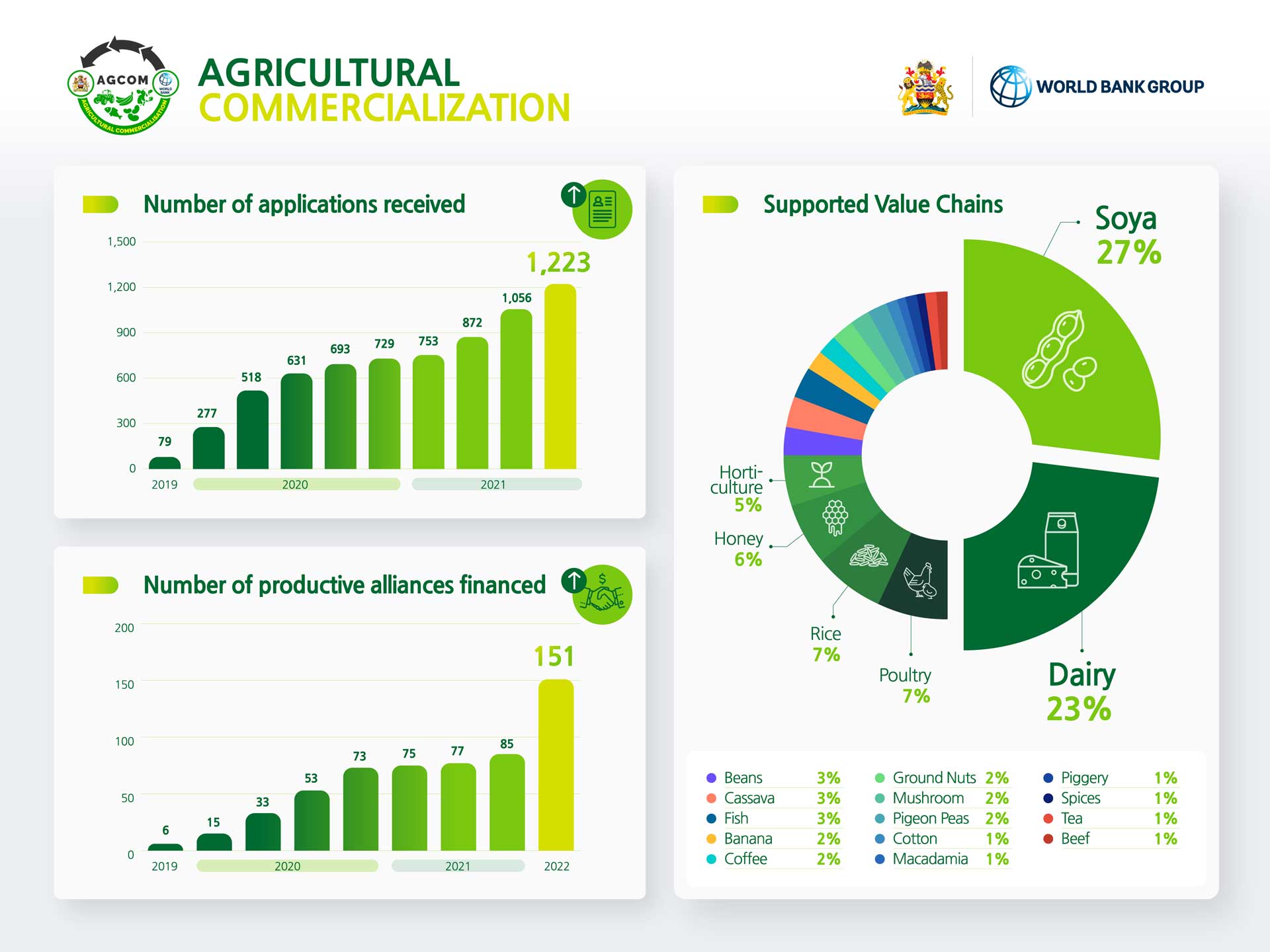 Youth farmers manually removing weeds in a soya field. Photo: Homeline Media/World Bank
Youth farmers manually removing weeds in a soya field. Photo: Homeline Media/World Bank
Prices for fertilizer, fuel, and food are surging throughout Africa, largely as a result of the war in Ukraine. The impact of this on Malawi is hard to predict, but it is safe to say the country is extremely exposed to external shocks. To make things worse, the prospect of a global food crisis is arriving on the heels of another crisis—the COVID-19 pandemic.
Despite this gloomy scenario, commercial smallholder farmers in Malawi, where 80% of the country’s population of 19 million (World Bank 2020) is employed in mainly low productive and subsistence agriculture, offer reason for hope. Some farmers are market-ready; simply put, they are oriented towards markets. These commercial farmers, in contrast to subsistence farmers, source inputs on the open market, mobilize private capital, create employment, and supply domestic and international markets with produce, primarily soybeans, groundnuts, milk, rice, tea, and coffee.
The World Bank-financed Agricultural Commercialization Project (AGCOM) is helping markets work for smallholders who already operate commercially or are in transition to becoming commercial. A few years in, the results are promising.

Not only is the AGCOM project demonstrating the benefits of investing in smallholder commercial agriculture, but its approach, known as “productive alliances,” is proving to be an effective nuts-and-bolts way for smallholders to get organized and improve their productivity and sales.
Let me highlight three hallmarks of the AGCOM approach:
The first is building farmer organizations and strengthening them. These allow smallholders to be able to seize market opportunities. With an average 0.7 hectares of land per household in Malawi, it is virtually impossible for individuals to make farming commercially viable. Food manufacturers, looking for raw produce, find it inefficient to buy food from widely dispersed and low-volume farms. Forming farmer organizations is the only way smallholders can offset their disadvantages, get more information, reduce costs, and reap the rewards that come from selling in volume.
The second hallmark of the approach is the lesson that linking up with buyers with unsatisfied demand can turn into quick wins. In the value chains covered by AGCOM, demand for agricultural products is growing. “Off-takers”—companies that buy produce and refine it, such as Sun Seed Oil Ltd and Malawi Dairy Industry—are operating at low capacity because of inconsistent supplies. If farmer organizations orient their production to meet this demand, this would result in a mutually beneficial, commercial relationship between the farmers and the buyers, offering short-term dividends.
The third of our hallmarks is putting farmers in the driver’s seat. The project operates through calls for proposals: Over 1,200 farmer organizations have submitted applications for grants under AGCOM. When the project started in July 2018, its critics said most farmers were incapable of managing grants and wouldn’t be able to come up with enough money to participate. There is overwhelming evidence to the contrary: 151 organizations are managing projects valued at US$24 million. Together, they have contributed US$2.1 million from their own pockets. Thus, the awarding of grants has shown itself to be an efficient way of reducing bureaucracy and boosting ownership.
AGCOM’s productive alliances are also fostering job creation. Opportunities for employment are crucial to buffer the impact of the looming food crisis and create opportunities for the 400,000-plus young people joining the workforce in Malawi every year. International experience shows that markets can create incentives to raise agricultural productivity that, in turn, create on-farm jobs via self-employment or casual labor. Gains in productivity can also result in off-farm jobs, upstream and downstream along value chains, as well as new jobs in associated industries and services.
More inclusive
Productive alliances promote inclusion and gender mainstreaming. Contrary to the common belief that farmer organizations exclusively represent elites, AGCOM-supported cooperatives comprise farmers with different levels of formal education. The most vulnerable members of the farmer organizations are the ones profiting the most from commercial partnerships with buyers. The farmer organizations are made up of a diverse mix of men and women, and among them, youth. To date, 57% of the beneficiaries have been women. These collaborative organizations allow women to match the levels of productivity of men by providing them access to inputs, technologies, and markets.
AGCOM has raised the expectations of smallholder farmers, agribusinesses, and government authorities. It has shown them that commercialized smallholder agriculture can be a source of growth to help Malawi weather the global food crisis. In the medium- and long-term, it can also help overcome poverty driven by the subsistence mono-cropping of maize (corn). Adopting productive alliances should become one of the most effective ways of realizing Malawi’s Vision 2063, in which agricultural productivity and commercialization are priorities.
In the current global crisis, smallholder commercial farmers are the flagbearers of hope.


Join the Conversation